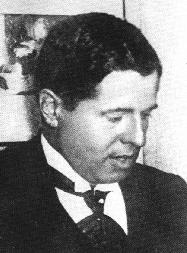Overview
Biography
Lucien Denis Gabriel Albéric Magnard (French pronunciation: [lysjɑ̃ dəni ɡabʁijɛl albeʁik maɲaːʁ]; 9 June 1865 – 3 September 1914) was a French composer, sometimes referred to as the "French Bruckner", though there are significant differences between the two composers. Magnard became a national hero in 1914 when he refused to surrender his property to German invaders and died defending it.
Biography
Magnard was born in Paris to François Magnard, a bestselling author and editor of Le Figaro. Albéric could have chosen to live the comfortable life his family's wealth afforded him, but he disliked being called "fils du Figaro" and decided to have a career in music based entirely on his talent and without any help from family connections.[1] After military service and graduating from law school, he entered the Paris Conservatoire, where he studied counterpoint with Théodore Dubois and went to the classes of Jules Massenet. There he met Vincent d'Indy, with whom he studied fugue and orchestration for four years, writing his first two Symphonies under d'Indy's tutelage. Magnard dedicated his Symphony No. 1 to d'Indy; and the two men always respected each other, despite their marked political differences (Magnard was pro-Dreyfus).
François Magnard did what he could to support Albéric's career while trying to respect his son's wish to make it on his own. This included publicity in Le Figaro. With the death of his father in 1894, Albéric Magnard's grief was complicated by his simultaneous gratitude to and annoyance with his father.
In 1896, Magnard married Julie Creton, became a counterpoint tutor at the Schola Cantorum (recently founded by d'Indy) and wrote his Symphony No. 3 in B-flat minor.
Magnard published many of his own compositions at his own expense, from Opus 8 to Opus 20. Similar to the oeuvres of Paul Dukas and Henri Dutilleux, Magnard's musical output numbered only 22 works with opus numbers.
In 1914, at the beginning of World War I, Magnard sent his wife and two daughters to a safe hiding place while he stayed behind to guard the estate of "Manoir de Fontaines" at Baron, Oise. When German soldiers trespassed, he fired at them, killing one of them, and they fired back and set the house on fire. It is believed[citation needed] that Magnard died in the fire, but his body could not be identified in the remains. The fire destroyed Magnard's unpublished scores, such as the orchestral score of his early opera Yolande, the orchestral score of Guercoeur (the piano reduction had been published, and the orchestral score of the second act was extant) and a more recent song cycle.
Work
Guy Ropartz, who had led a concert performance in Nancy of the third act of Guercoeur in February, 1908, reconstructed from memory the orchestration of the acts that had been lost in the fire. The Paris Opéra gave the belated world premiere in 1931. (A complete recording of Guercœur was released by EMI Angel/Pathé Marconi in 1990. It features Hildegard Behrens, Nadine Denize, José van Dam, and Gary Lakes, with the Orchestre du Capitole de Toulouse conducted by Michel Plasson.)
Magnard's musical style is typical of contemporary French composers, but occasionally, as in the four completed symphonies, certain passages foreshadow the music of Gustav Mahler. His use of cyclic form and occasional incorporation of chorale earned him the nickname of "French Bruckner." Although Bruckner used cyclical forms long before d'Indy "trademarked" the concept to César Franck's name, Magnard's handling of cyclical form is more Franckian than Brucknerian. In his operas, Magnard used Richard Wagner's leitmotiv technique
Magnard's chamber works include a string quartet, a quintet for piano and winds, a piano trio, a violin sonata (in G, opus 13) and a cello sonata (in A, opus 20). A few more were published posthumously, including the Quatre poèmes en musique, four songs for baritone and piano.[2]
List of compositions
- Trois pièces pour piano, Op. 1
- Suite dans le style ancien, Op. 2, for orchestra
- Six poèmes, Op. 3, for voice and piano
-
- 1. "À Elle"
- 2. "Invocation"
- 3. "Le Rhin allemand"
- 4. "Nocturne"
- 5. "Ad fontem"
- 6. "Au poète"
- Symphony No. 1 in C minor, Op. 4
- Yolande, opera (1888–1891), Op. 5
- Symphony No. 2 in E, Op. 6
- Promenades, Op. 7, for piano
- Quintet for piano, flute, oboe, clarinet & bassoon in D minor, Op. 8
- Chant funèbre, Op. 9
- Overture, Op. 10
- Symphony No. 3 in B-flat minor, Op. 11
- Guercoeur, opera (1897–1900), Op. 12
- Sonata for Violin and Piano in G, Op. 13
- Hymne à la justice, Op. 14
- Quatre poèmes, Op. 15, for baritone and piano
- String Quartet in E minor, op. 16
- Hymne a Venus, Op. 17
- Trio for Piano and Strings in F minor, Op. 18
- Bérénice, opera (1905–1909), Op. 19
- Sonata for Cello in A, Op. 20
- Symphony No. 4 in C-sharp minor, Op. 21
- Douze poèmes, Op. 22
- En Dieu mon esperance
- À Henriette

Index: 7.1
Type: Person Male
Period: 1865.7.9 - 1914.9.3
Age: aged 49
Area :France
Occupation :Composer
Periods :Romantic Music
